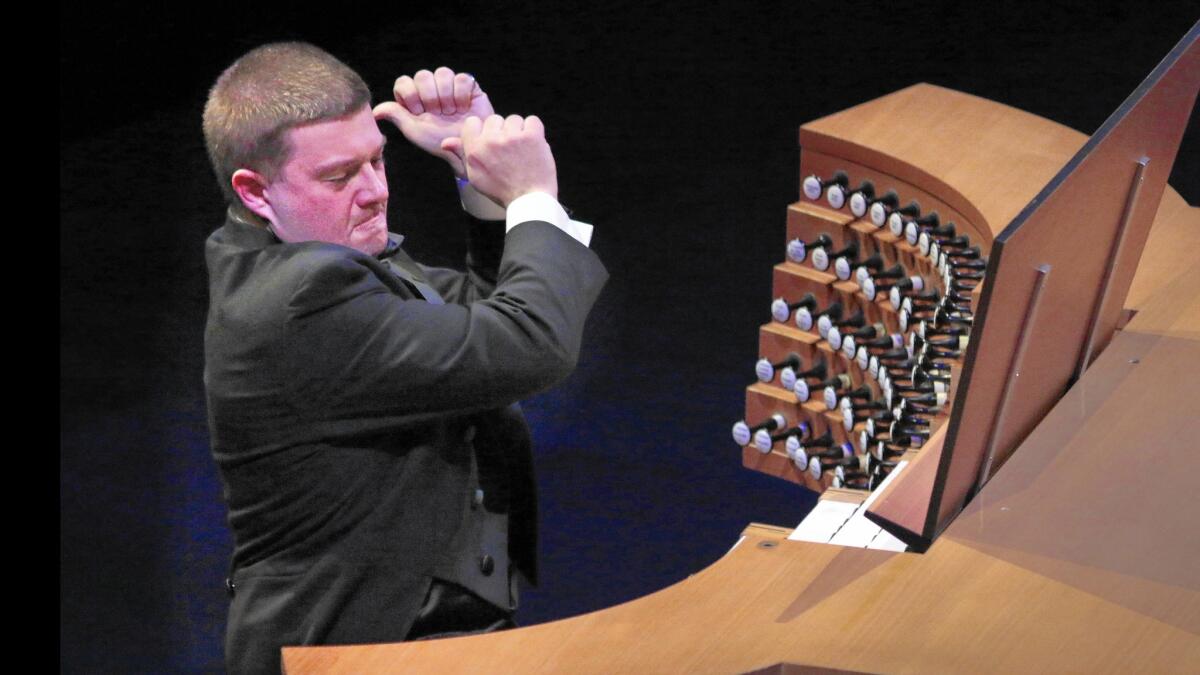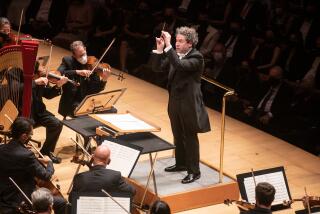Review: Originality enlivens the birthday party for Hurricane Mama

Hurricane Mama, the Walt Disney Concert Hall organ, is a young mama, but she’s already made her mark as the model for a 21st century organ. For her 10th birthday party Sunday night, she had a brood of nine performers on hand to celebrate. And the first thing always evident when confronted by a collection of organists is that they are more than a brood. They are a breed all their own.
The organ demands a special strain of creativity. That comes partly from the many-keyboarded monster’s magnificent degree of tonal versatility. Every organ is different; every organ has a vast number of sonic possibilities; and very few organ pieces expressly notate exactly what stops to use. Even when composers do indicate the sounds, those colors will differ depending on the instrument and the venue. The organist is always an orchestrator.
The organ is also the only classical instrument for which improvisation is part of the standard training. Most of all, the organ is the single most direct instrumental conduit to the ego. When the pipes roar, they vibrate everything in the vicinity. The timid musician should simply stay home.
Organists are, thus, individuals. So it was no surprise that on this occasion, birthday-party attire among the nine performers ranged from formal to conventional to flashy in both men and women. Cameron Carpenter wore a sparkling hoodie. Carol Williams proudly bared her shoulder to show off her treble-clef tattoo. Aaron David Miller was the only performer in concert tails. Michael Barone, the evening’s genial and informative host, changed his tie at least four times.
Of the 10 pieces on the program, not a single one was a major organ work. Although the organ repertory is pretty great, organists love organ arrangements, and they often make their own when not otherwise improvising or composing. Hand in hand with their eccentricities as performers, organists tend to have an unusual degree of enthusiasm for outlier music. No surprise again, that Mama’s 10th was an evening of oddities.
Ignoring Bach’s extraordinary body of organ music, Ken Cowan began the program with Max Reger’s powerful arrangement of the composer’s Chromatic Fantasia and Fugue for harpsichord. Bach’s chromatic harmonies, so prickly when heard on a delicately plucked string, became monumental and modern. Cowan’s performance was articulate and thrilling.
Frederick Swann, the first to give a recital on the Disney behemoth, turned to M. Searle Wright’s meditative Lyric Rhapsody and Robert Hebble’s carnivalesque “Heraldings,” celebrating the organ’s ability to sound like a brass band. Both are little known composers with whom he had worked.
Cherry Rhodes — who represented USC and who also helped inaugurate Hurricane Mama — had the quirkiest and most obscure repertory. Riffing off the title of Debussy’s “Prelude to the Afternoon of a Faun,” she chose “Sportive Fauns,” a moody piece by the early 20th century Hungarian composer Dezsö d’Antalffy-Zsiross and “Afternoon a Toad” by the late L.A. organist, pedagogue, poet and outsider artist Clarence Mader.
It’s hard to find out much about Mader, who died in 1971. Most of his music is unpublished. “Toad,” written sometime before 1949, is a wonderfully funky piece inspired by prettified midcentury French organ music and by (the toad?) popular American dance music.
Christoph Bull (representing UCLA) and Chelsea Chen had another oddity. The two organists took advantage of Disney’s two organ consoles — the main one in the loft behind the stage and a remote keyboard that can be used onstage — for a lavishly organ-intensive transcription of Ravel’s “Bolero” by Hans Uwe Hielscher. Williams, who is civic organist of San Diego, played two bright, theatrical pieces of her own — “Venus Toccata” (dedicated to the Disney organ maker Manuel Rosales) and “Freedom” (dedicated to architect Frank Gehry), along with her jazzy arrangement of Lou Reed’s “Walk on the Wild Side.”
Miller was the evening’s improviser. Taking suggestions from the audience, he came up with “Twinkle, Twinkle Little Star,” Beethoven’s Ninth Symphony, an original tune someone submitted, “Over the Rainbow” and the theme from “Superman.” He riffed from one to the next, turning the organ into an audible color wheel as he went along. Most of the time Miller produced an impressive haze of swirling virtuosity, with “Somewhere Over the Rainbow” as the inspired slow, quiet bit.
Carpenter was the final performer, and he repeated his appropriately spooky transcription of Scriabin’s Fourth Piano Sonata that he had played in his appearances with the Los Angeles Philharmonic last week.
There was, alas, no cake, although Carpenter did come up with a dazzling “Happy Birthday” encore. There were, though, decorations.
Robin Gray covered the stage and organ pipes with ornamental lighting. Chris Donovan projected close-ups of the players on the wood sidings on either side of the organ pipes, similar to the kinds of video offered at the Hollywood Bowl. The camera angles were limited, but the wood turns out to make a good screen for high-definition images.
At one point, Barone interrupted Deborah Borda, L.A. Phil president and chief executive, as she explained to the audience how composer Terry Riley had named the organ Hurricane Mama.
“I thought you were Hurricane Mama,” he said.
More to Read
The biggest entertainment stories
Get our big stories about Hollywood, film, television, music, arts, culture and more right in your inbox as soon as they publish.
You may occasionally receive promotional content from the Los Angeles Times.







